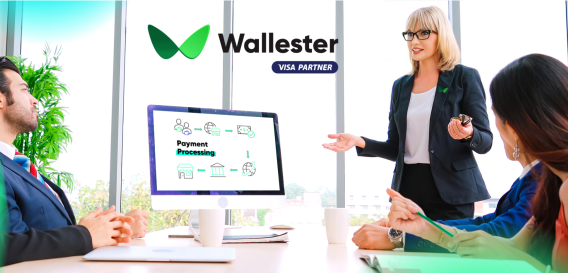Financial technology has existed for almost as long as the financial services industry. But after the economic crisis 2008, companies with more efficient and modern technologies displaced traditional e-commerce service providers.
Because of the Internet’s popularity, many online stores and services have sprouted up. Now everyone can order any product or use any type of service online, which an independent sales organisation can offer. But how can the potential buyers pay for it? Perhaps, it is not the best idea to waste your time and go to the bank’s branch. Electronic money greatly simplifies this process and minimises all complications. It allows people to make virtual credit card payments, as well as debit ones. Deals completed with electronic money provide much more convenience than traditional purchases with real currency.
Why start a payment processing business?
Payment systems are considered the most convenient way to conduct financial transactions. They allow carrying out a vast range of operations, such as:
- payment of utilities, taxes and fines;
- payment for the services of Internet providers and mobile operators;
- shopping in online stores, and even in online games or when you buy media traffic on Facebook, it is possible to pay to the seller`s direct merchant account;
- money transfers to other users of the payment system;
- currency exchange and multi-currency transactions;
- repayment of loans and credits;
- putting funds in a bank account, as well as withdrawing them.
Today each person needs the ability to make online transactions, and we understand that the market for payment providers is vast and has lots of potential. Direct bank account transactions carve a path for new technologies.
How does an online payment system work?
A payment system is a set of tools and procedures for purchasing goods/services and transferring money without the need for cash by using bank cards and electronic payments.
Now let’s describe how cashless payment processing works when you pay for your online purchases while defining the main stages of the set process.
Stage 1.
The buyers identify the goods/services they wish to acquire, given that they have a payment card with sufficient monetary funds. The organisation that issued the card is called the issuer.
Stage 2.
The buyer enters the bank card details on the website or application of the online store in order to check out the purchase.
Stage 3.
The data enters the payment gateway, which is encrypted, and then sent to the acquiring financial organisation, which cooperates with the online store. This organisation is called the acquirer.
Stage 4.
After the payment gateway, the encrypted data is sent to the electronic payment system, which contacts the card issuer in order to obtain permission to reserve the funds.
Stage 5.
The issuer accepts or denies the authorisation based on the status of the payment card, which may include the amount of available funds, various limits, expiration date, etc.
Stage 6.
If authorisation is confirmed, the issuer records the purchase amount, which is later settled with a card schemes provider, such as Visa or Mastercard. This means that the set provider enables the actual money movement from the issuer’s account to one of the acquirers.
Stage 7.
The acquiring bank credits the purchase amount to the store’s current account also called the merchant account.
Types of online payment systems
Generally, the payment processing business can be divided into two big types: banking and non-banking payment systems. Of course, we are interested in the second type because this market is new, and private payment businesses can find growth opportunities here.
Moreover, online payment systems can be defined by the following classifications:
- digital cash – this system generates a private form of currency that can be spent at e-commerce sites;
- online stored value system, which relies on prepayments, debit cards, or checking accounts to create value in an account that can be used for e-commerce shopping;
- digital accumulating balance payment system collects small charges and bills the consumer periodically (suitable for micropayments);
- digital credit accounts – such systems extend the online functionality of existing credit card payment systems;
- digital checking – these systems create digital checks for e-commerce remittances and extend the functionality of existing bank checking systems.
How to start a payment processing company in 2023? What are the options?
When you develop payment software, you need to clearly envision your business model and develop many relevant technical solutions during the software building stage. Payment software should be able to process thousands of simultaneous parallel requests for debiting and crediting money. You should establish whether you need your own payment gateway or a custom payment gateway. Remember that payment software must have a convenient and understandable interface for clients with a simple registration process.
What is a payment service provider?
A payment service provider (PSP), such as PayPal, Stripe, Skrill, or Payler, acts as an intermediary between the business and the acquiring bank. Suppose you plan to work with a payment service provider. In that case, it must be concluded within a separate agreement with the acquirer, which states that the acquiring organisation is responsible for financial settlements. The payment service provider guarantees security, uninterrupted payments and prompt support for any issues.
What is a payment facilitator?
A payment facilitator, similarly to a payment service provider, is also an intermediary. But the key difference between them is that the payment facilitator independently conducts financial settlements. On the market, you can meet examples of the payment facilitator companies such as Shopify, Xero, and Worldpay. The facilitator concludes an agreement with the bank and receives his individual number, under which all sellers or, as they are also called, sub-merchants, are already registered for the obtaining merchant account.
Building the payment processing software from scratch step by step:
✅ Step 1.Determine in your business plan what features you want for your app, such as the ability to track sales, send invoices and manage customer information.
✅ Step 2. Select the payment processor that will process transactions for your application.
✅ Step 3. Determine in your business plan the type of your future application, which depends on the type of payments (credit card and debit card payments, digital wallets, direct debit and bank transfer).
✅ Step 4. Choose the platform. Start with one platform, such as iOS, and then consider Android once your business becomes profitable.
✅ Step 5. In your business plan, define key functions such as notifications, in-app message exchange, a digital wallet, available transaction history, and so on.
✅ Step 6. You must understand that the security appliance for users’ financial data is a top priority of the payment processing software. Establish a reliable security system for your future users.
✅ Step 7.The last stage is choosing a technical stack and starting the development process. The best way is to use the no-code platforms.
Conquering online payments with a Wallester White Label
Wallester White Label offers the possibility to issue your own multifunctional virtual and physical branded Visa cards with an exclusive design suitable for different business processes. Moreover, Wallester can help you increase the functionality of payment instruments and simplify financial processes. Ready-to-use Wallester platform can be combined with any IT system. It can save you time and money, expand the package of offered services, and help you take the leading position on the market!
How much does it cost to start a payment processing company?
A wide range of IT firms provides development services, which can include the creation of your own payment software. You can find reasonable developers from CIS countries. Here prices start from €15 000. The fees for software certification can reach €10 000. Also, you need to integrate your product with the bank and processors, which costs €4 000 – €10 000. The most expensive part is the tokenisation appliance, its price starts from €40 000. Moreover, do not forget to include in your business plan an annual PCI audit – approximately €20 000 per year.
Factors affecting the cost of starting a payment processing company
Below you can see the various factors which have an impact on the development budget for the application, such as the payment processing business:
- the number of functions and screens of the application;
- the complexity of the application;
- third-party integrations;
- implementation of modern security and confidentiality protocols;
- the size, level and experience of the application development team;
- quantity of application developers working on one project.
Learn more about the features of Wallester’s White Label solution.
Wallester White Label is a ready-made set of IT solutions, which allows the business owners of the payment processing company to offer clients the best service and save their financial resources.
What does the payment platform have to offer?
Besides the issuance of branded Visa cards, Wallester also can ensure the opportunity to issue physical or virtual cards with the possibility to tokenise them. As you understand, such advantages allow you to connect such cards and accept payments via Apple Pay, Google Pay, Fitbit Pay, Garmin Pay, or Samsung Pay mobile payment systems, providing secure and convenient transactions.
With Wallester, you can earn extra income by setting fees for monthly card maintenance, ATM withdrawal, card replacement and other customer services. Your clients will have the possibility to use the Wallester notification system and get actual information about all their transactions in real-time.
Main risks and challenges of a PSP business
Data security and privacy are major risks for payment service providers that interact with customers through a platform or web interface. Online payment processor with their company’s payment processing activities is an attractive targets for hackers. Digital risk is a main problem for payment service providers due to the fraudulent environment and their responsibility to secure data. Also, fintech companies should check third-party risks if they use outsourcing services. Be aware that insurers are not familiar with such a business and often refuse to insure risks of the payment business. And also, do not forget about complicated industry compliance and incorporate this point in your business strategy.
Conclusion
Debit and credit card processing applications allow businesses to implement various payment methods for online services and provide customers with more convenience. We can see the growing demand for the services, which allows us to make the transaction process more comfortable and agile. No doubt that now is a good time to enter the payment processing business. Various ready-made fintech solutions, such as Wallester, can help you create an effective and profitable own business with the credit card processing company.
FAQ
Is it hard to start a debit/credit card processing company?
Electronic payments are the most difficult part of working in the field of e-commerce. It is not so simple to start a debit/credit card processing company because you need to learn a lot about the payment business. Still, it has become much more possible due to the appearance of ready-made IT solutions such as Wallester.
What is the difference between a payment gateway vs payment processor?
The main difference between a payment gateway and a payment processor is that a payment gateway is a tool or service that rejects or approves every transaction between your customers and your online store. A payment processor performs the entire operation. The payment processor provides a full range of transfer and payment processing services, while the payment gateway is only one part.
How do payment processors make money?
Payment processors serve payment solutions as their main product and charge a fee on every transaction. It can also take payments to get you started with its payment solutions.


